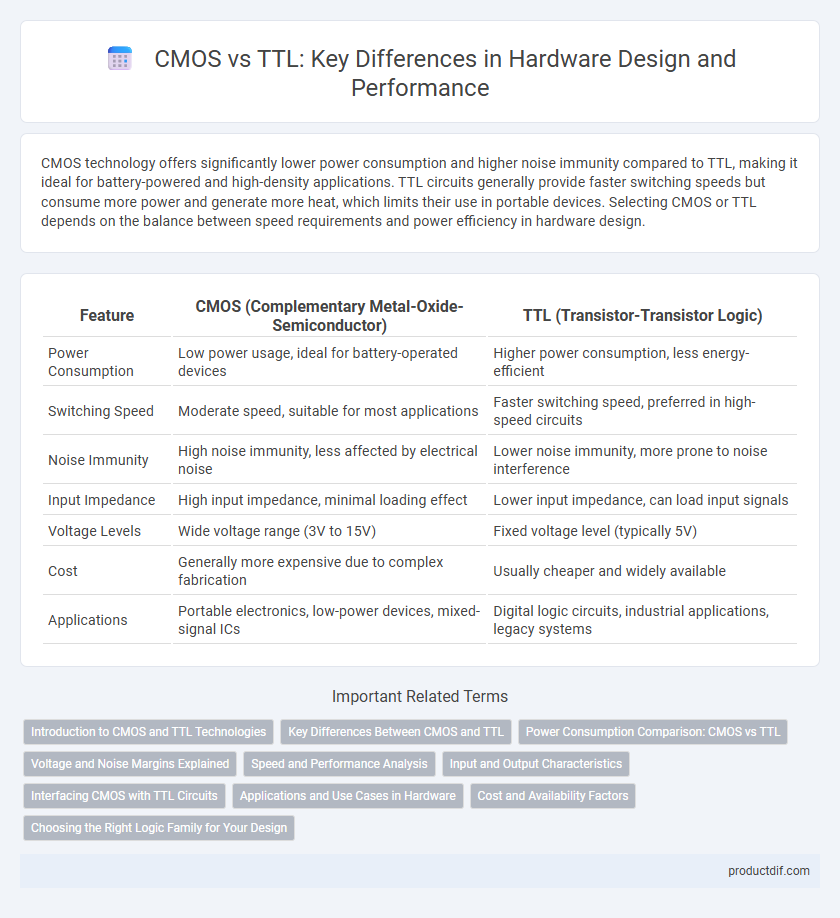CMOS technology offers significantly lower power consumption and higher noise immunity compared to TTL, making it ideal for battery-powered and high-density applications. TTL circuits generally provide faster switching speeds but consume more power and generate more heat, which limits their use in portable devices. Selecting CMOS or TTL depends on the balance between speed requirements and power efficiency in hardware design.
Table of Comparison
| Feature | CMOS (Complementary Metal-Oxide-Semiconductor) | TTL (Transistor-Transistor Logic) |
|---|---|---|
| Power Consumption | Low power usage, ideal for battery-operated devices | Higher power consumption, less energy-efficient |
| Switching Speed | Moderate speed, suitable for most applications | Faster switching speed, preferred in high-speed circuits |
| Noise Immunity | High noise immunity, less affected by electrical noise | Lower noise immunity, more prone to noise interference |
| Input Impedance | High input impedance, minimal loading effect | Lower input impedance, can load input signals |
| Voltage Levels | Wide voltage range (3V to 15V) | Fixed voltage level (typically 5V) |
| Cost | Generally more expensive due to complex fabrication | Usually cheaper and widely available |
| Applications | Portable electronics, low-power devices, mixed-signal ICs | Digital logic circuits, industrial applications, legacy systems |
Introduction to CMOS and TTL Technologies
CMOS (Complementary Metal-Oxide-Semiconductor) technology utilizes both NMOS and PMOS transistors to create logic gates with low power consumption and high noise immunity, making it ideal for modern integrated circuits. TTL (Transistor-Transistor Logic) technology relies on bipolar junction transistors to achieve faster switching speeds but typically consumes more power than CMOS. Understanding the electrical characteristics and fabrication processes of CMOS and TTL is essential for designing efficient digital circuits and optimizing performance in various hardware applications.
Key Differences Between CMOS and TTL
CMOS (Complementary Metal-Oxide-Semiconductor) technology offers lower power consumption and higher noise immunity compared to TTL (Transistor-Transistor Logic) circuits, which operate faster but consume more power. CMOS devices exhibit a wider operating voltage range, making them suitable for battery-powered and portable applications, whereas TTL circuits typically function within a fixed 5V supply. The input impedance of CMOS is significantly higher, reducing input current draw, while TTL inputs require more current, influencing overall system power efficiency.
Power Consumption Comparison: CMOS vs TTL
CMOS technology significantly reduces power consumption compared to TTL due to its high input impedance and static power usage, which only occurs during transistor switching, making it ideal for low-power applications. TTL circuits consume more power continuously because of their lower input impedance and current flow through multiple transistors even when idle. This difference results in CMOS being the preferred choice for battery-operated and energy-efficient hardware designs.
Voltage and Noise Margins Explained
CMOS technology operates with a wider supply voltage range, typically from 3V to 15V, offering higher noise margins compared to TTL, which usually runs at 5V with lower noise tolerance. The noise margin in CMOS devices can reach up to 45% of the supply voltage, enhancing signal integrity and reducing error rates. TTL circuits generally have smaller noise margins around 0.4V to 0.8V, making them more vulnerable to voltage fluctuations and noise interference.
Speed and Performance Analysis
CMOS technology offers significantly lower power consumption compared to TTL, enhancing overall efficiency in high-speed applications. TTL circuits generally provide faster switching speeds but consume more power, limiting their use in energy-sensitive designs. Performance analysis shows CMOS excels in scalability and noise immunity, making it preferred for modern high-frequency and complex integrated circuits.
Input and Output Characteristics
CMOS technology features high input impedance and low input current, minimizing power consumption and making it ideal for battery-operated devices, while TTL exhibits lower input impedance with higher input currents. TTL outputs typically provide a stronger drive capability due to their totem-pole transistor configuration, allowing faster switching speeds and better noise margins compared to the usually weaker CMOS output drive. The output voltage levels of CMOS are closer to the power supply rails, offering greater noise immunity, whereas TTL levels are fixed and less tolerant to voltage fluctuations.
Interfacing CMOS with TTL Circuits
Interfacing CMOS with TTL circuits requires level shifting because CMOS operates at higher voltage levels, typically 3.3V to 15V, while TTL usually uses a 5V supply with a logic high threshold around 2V. Proper interfacing involves using pull-up resistors or open-collector outputs on TTL inputs to ensure compatible voltage levels without damaging either device. Optocouplers or specialized level translators can also facilitate seamless communication between CMOS and TTL components in mixed-signal systems.
Applications and Use Cases in Hardware
CMOS technology is widely used in battery-powered and portable devices due to its low power consumption and high noise immunity, making it ideal for smartphones, microcontrollers, and digital cameras. TTL circuits are preferred in high-speed digital logic applications such as computer motherboards and industrial control systems due to their faster switching times and robust performance under higher frequencies. The choice between CMOS and TTL depends on the need for power efficiency versus speed and signal integrity requirements in hardware design.
Cost and Availability Factors
CMOS technology generally offers lower production costs and higher energy efficiency compared to TTL, making it more cost-effective for large-scale manufacturing. TTL components, once widely available, have become less common due to the shift towards CMOS dominance in integrated circuits, resulting in limited availability and potentially higher prices. The widespread use of CMOS in modern electronics ensures better accessibility and a broader range of options for designers seeking cost-effective hardware solutions.
Choosing the Right Logic Family for Your Design
CMOS (Complementary Metal-Oxide-Semiconductor) and TTL (Transistor-Transistor Logic) are pivotal logic families, each suited for specific design requirements based on power consumption, switching speed, and noise immunity. CMOS technology offers low power consumption and high noise immunity, making it ideal for battery-operated and high-density integrated circuits, while TTL provides faster switching speeds favored in applications demanding rapid logic transitions. Selecting the right logic family involves balancing these factors with system voltage levels and interfacing compatibility to optimize overall circuit performance.
CMOS vs TTL Infographic

 productdif.com
productdif.com